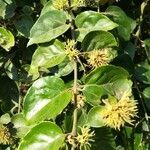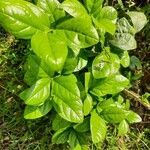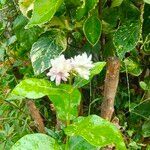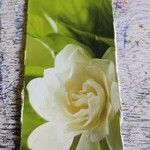| Therapeutic use
|
Hair loss (flower), Antidotes (flower), Antiperspirants (flower), Antipruritics (flower), Diarrhea (flower), Ear diseases (flower), Eye diseases (flower), Fever (flower), Galactogogues (flower), Galactorrhea (flower), Graves ophthalmopathy (flower), Headache (flower), Hernia (flower), Hiccup (flower), Lactation disorders (flower), Leprosy (flower), Mental disorders (flower), Mouth diseases (flower), Nasal disease (flower), Puerperal disorders (flower), Ulcer (flower), Vomiting (flower), Abscess (leaf), Anti-bacterial agents (leaf), Antifungal agents (leaf), Antineoplastic agents (leaf), Breast neoplasms (leaf), Diarrhea (leaf), Eye drops (leaf), Fever (leaf), Furunculosis (leaf), Galactogogues (leaf), Graves ophthalmopathy (leaf), Lactation disorders (leaf), Menstruation-inducing agents (leaf), Mental disorders (leaf), Periodontal diseases (leaf), Pharyngitis (leaf), Skin diseases (leaf), Skin ulcer (leaf), Ulcer (leaf), Vision disorders (leaf), Warts (leaf), Wounds and injuries (leaf), Abscess (root), Eye drops (root), Galactogogues (root), Graves ophthalmopathy (root), Lactation disorders (root), Menstruation-inducing agents (root), Mental disorders (root), Periodontal diseases (root), Puerperal disorders (root), Ulcer (root), Vision disorders (root), Headache (unspecified), Anesthetic (unspecified), Anodyne (unspecified), Antiemmenagogue (unspecified), Collyrium (unspecified), Conjunctivitis (unspecified), Cosmetic (unspecified), Dysentery (unspecified), Fever (unspecified), Fracture (unspecified), Lactifuge (unspecified), Perfume (unspecified), Poison (unspecified), Sapraemia (unspecified), Skin (unspecified), Sore (unspecified), Tea (unspecified), Tumor (unspecified), Tumor(Breast) (unspecified), Venereal (unspecified), Insomnia (unspecified), Sedative (unspecified), Abdomen (unspecified), Congestion (unspecified), Decongestant (unspecified), Dermatosis (unspecified), Lotion (unspecified), Breast diseases (unspecified), Central nervous system depressants (unspecified), Dermatitis (unspecified), Hypotension (unspecified), Lactation disorders (unspecified), Mental disorders (unspecified), Mouth diseases (unspecified), Periodontal diseases (unspecified), Skin diseases (unspecified), Stomatitis (unspecified), Ulcer (unspecified), Vision disorders (unspecified), Visual perception (unspecified), Cooling effect on body (unspecified), Cooling effect on body (whole plant), Cardiovascular system (whole plant excluding root), Central nervous system diseases (whole plant excluding root)
|






